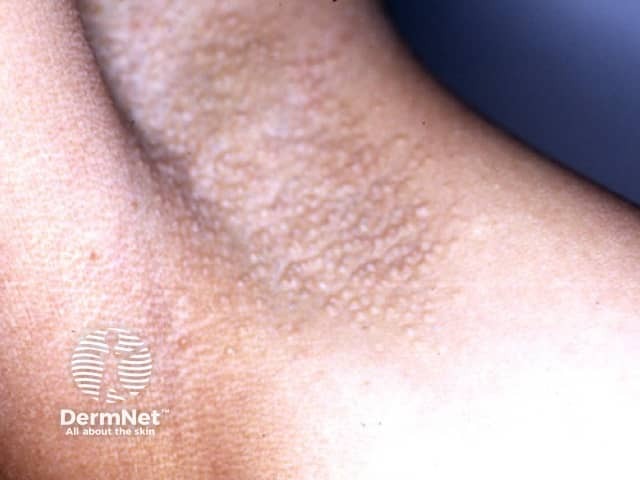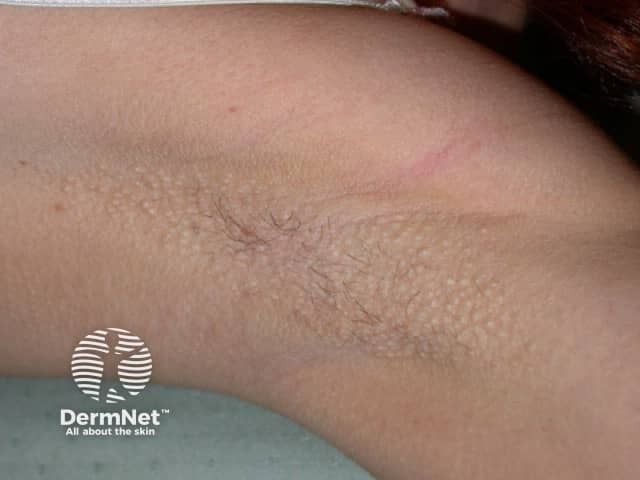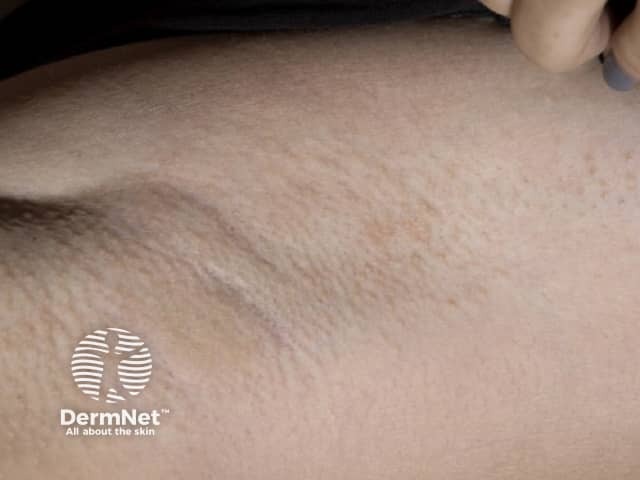Main menu
Common skin conditions

NEWS
Join DermNet PRO
Read more
Quick links
Fox-Fordyce disease — extra information
Fox-Fordyce disease
Author: Vanessa Ngan, Staff Writer, 2005. DermNet Update July 2021
Introduction Demographics Causes Signs and symptoms Diagnosis Treatment Outcome
What is Fox-Fordyce disease?
Fox-Fordyce disease is a rare skin disorder in which apocrine sweat is trapped with resultant inflammation. It is also called apocrine miliaria, apocrine duct occlusion, and sweat retention disease.
Who gets Fox-Fordyce disease?
Fox-Fordyce disease mainly affects post-pubertal women between the ages of 13 and 35 years. Children and males are sometimes affected.
What causes Fox-Fordyce disease?
The cause of Fox-Fordyce disease is unknown. Apocrine sweat becomes trapped by a keratotic plug in the hair follicle. The apocrine sweat ducts within the epidermis rupture and leak to cause inflammation and intense itch.
Factors identified as playing a part in the development of the condition include:
- Emotional and hormonal influences
- Alterations in sweat components
- Laser hair removal.
What are the signs and symptoms of Fox-Fordyce disease?
Fox-Fordyce disease is characterised by itchy bumps around the hair follicles of the underarm area, pubic region, and around the nipples as apocrine sweat glands are found only in these areas.
Fox-Fordyce disease may result in very intense itch that disturbs sleep, but in some cases is asymptomatic. The condition frequently occurs under conditions of heat, humidity, friction, and stress.
Common clinical signs of Fox-Fordyce disease include:
- Dome-shaped flesh-coloured to small reddish papules affecting almost every hair follicle in the area
- Bilateral
- Dark, thickened, dry skin as a consequence of scratching (lichenification)
- Reduced or absent sweating in the affected area.
Fox-Fordyce disease of the axilla




Dermoscopy features of Fox-Fordyce disease
- Folliculocentric papule
- Multiple light brown to dark structureless areas, lack pigment network
- Central hyperkeratotic plug in each papule
How is the diagnosis of Fox-Fordyce disease made?
Fox-Fordyce disease is usually diagnosed on the history and clinical appearance of the rash.
Skin biopsy may require serial sectioning to demonstrate the characteristic histology findings of:
- Keratotic plug above the point where the apocrine duct joins the hair follicle
- Spongiosis and vesicle formation in the follicular infundibulum and epidermis
- Mild to moderate perifollicular infiltrate of neutrophils and chronic inflammatory cells
- Xanthomatous foamy cells.
What is the treatment for Fox-Fordyce disease?
There is no cure for Fox-Fordyce disease. Treatments used with variable degrees of success include:
- Topical retinoids
- Topical steroids
- Topical and oral antibiotics.
What is the outcome of Fox-Fordyce disease?
Fox-Fordyce disease may persist for many years. In some instances, it may clear up in pregnancy. In others, it may resolve at the menopause or continue to persist.
Bibliography
-
Miao C, Zhang H, Zhang M, Zhang X. Fox-Fordyce disease. An Bras Dermatol. 2018;93(1):161–2. doi:10.1590/abd1806-4841.20187348
- Sammour R, Nasser S, Debahy N, El Habr C. Fox-Fordyce disease: an under-diagnosed adverse event of laser hair removal?. J Eur Acad Dermatol Venereol. 2016;30(9):1578–82. doi:10.1111/jdv.13680. PubMed
- Singal A, Kaur I, Jakhar D. Fox-Fordyce disease: dermoscopic pperspective. Skin Appendage Disord. 2020;6(4):247–9. doi:10.1159/000508201. PubMed Central
Other websites
- Fox-Fordyce Disease — Medscape Reference
- Fox-Fordyce disease — British Association of Dermatologists
